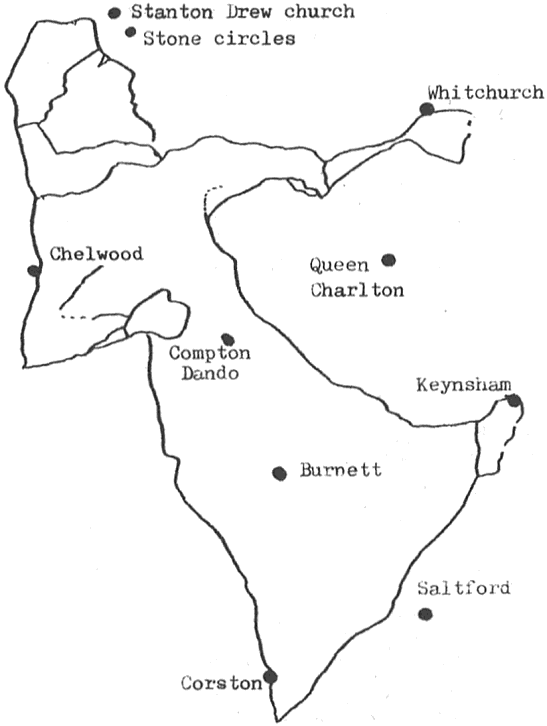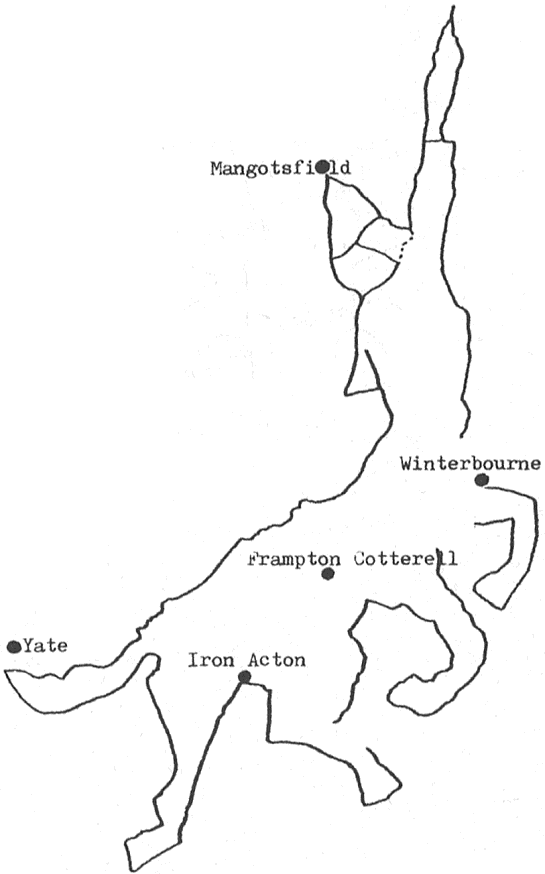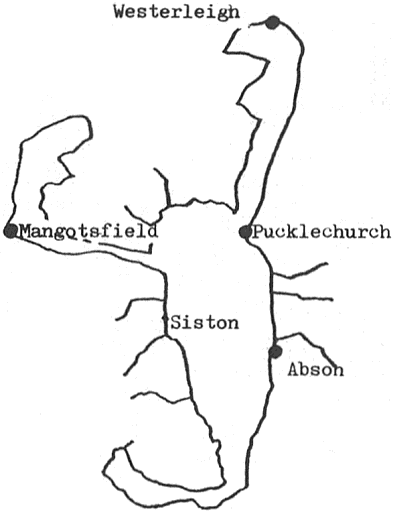
Journal of Geomancy vol. 3 no. 4, July 1979
{100}
STUDIES ON THE BRISTOL ZODIAC No. 1
The phenomenon of the terrestrial zodiac defies analysis; no sooner has the student decided to be rigid and scientific in outlook, then|than the zodiac plagues him with double meanings, impossible placenames, cosmic puns; if he should change his mind and seek inwardly, the figures dissolve into a tissue of myth.

So the study of the Virgin and the Huntsman has led me alternately from elation to despair; from a miserable search for the tips of the legs of the Huntsman’s Horse, to a 15 minute reverie on the nature of the Earth virgin, sat beneath the trees overlooking the ancient City of Bath. At some locations within this zodiac there are church carvings which immediately show that this earthen enigma was recognized in Medieval times; as at Nailsea, for example, where the head and horns of the earthen Taurus are repeated in stone on the ancient supporters of the roodloft, in precisely the same configuration. It is winged as the symbol of St Luke, yes; but the other three evangelists are missing, and they are nearly always found in sets.
No church carving that I have ever yet found shows the Virgin of Stanton Drew. Her figure was first revealed by the profile of a heavy, almost Semitic face clearly outlined by Stanton Lane, from Pensford to Stanton Drew. Behind, her bonnet sits closely on her head; a lock of hair hangs over her shoulder at Pensford. Her eye is marked by roads at Upper Stanton Drew; she has a well to represent her nostril, and a stream runs between her lips. Her wheatsheaf runs out across to Whitchurch, clearly grasped by her thumb, outlined by roads at Hursley Hill, where a cross sits on her knuckle. Her voluminous skirt spreads over the hills to Corston and Keynsham, and her right arm is drawn back as if she is dancing, with the hand lying before Compton Dando. Her front foot thrusts out from under the hem of her dress at Keynsham, sadly injured now by rail and road.
The circles at Stanton Drew, which lie close to her face, were connected with the planet Venus, so Ernest Sibree says in his Aspects of the History of Stanton Drew, and were, of course, known as the Weddings. The legend that the stones there represent dancers at a wedding turned to stone is too well known to be repeated in full, but it is not so well known that the stones at the Cove were once called ‘The Parson, the Bride and Groom’. Here is the bride, turned to stone, yet nevertheless laid on her back; she motionlessly dances eternity away amongst the hills {101} of Somerset. The Groom we shall meet in a .moment. And so it is apt that cattle still graze around the stones of Stanton Drew, and corn still grows around its weddings; here fertility ceremonies remembered by the legends must have continued well down the ages, and they could not fail to he seen by the Great Bride, for the circles are right in front of her eye.
She is remembered in Keynsham, too, as St Keyne. Legend says that Keyne came to the valley, and it was full of venomous reptiles. She turned them to stone, and they can still be seen, built into the walls of Keynsham’s churches and houses. She was a beautiful virgin, they say, but the reptiles she petrified were hideous – could this be a memory of the giant effigies of Virgo and Scorpio that lie on either side of Keynsham today? For Scorpio figures are often known to have legends of fearful serpents, as Warmley may be trying to tell us here. The earliest form of Keynsham’s name we have is CAEGINSHAMME, but it is still pronounced the same!
Even Whitchurch remembers her, for the local histories say that the earliest church in the village was dedicated to St White, a great virgin saint, but her legend is not remembered now in Whitchurch. At Compton Dando, there is a great Roman stone built into the buttress of the NE of the church; one side represents Jupiter, but a second has what seems to be a perfect river goddess, with twin serpents. Fondly, she is remembered as ‘young’, indeed, a ‘chick’, for the River Chew, in Welsh, means chicken (cyw). Here is the link with Glastonbury’s Mother Cary, and here too with her aspects as Diana: John Skinner, the Camerton antiquary, found a cross-shaft at Compton which bore a picture of Diana’s animal, the deer. Queen Charlton, nearby, is said to derive its name from Catherine Parr, who gave it to Henry VIII, but it seems rather a coincidence. …
Whether a Roman road cuts her wheatsheaf, it is impossible to say; archaeologists say it should be there, but they haven’t found it yet. On her back is Lady Farm, at Chelwood, and perhaps Lords and Ladys Wood, at Hunstrete, are telling us of the lady of the hills, and her giant consort, Sagittarius, far away on the other side of Bristol.

The carver of the head of the ancient cross at Pensford certainly knew, for he did something quite unprecedented, and carved an Adam and Eve, on the stone, which is now built into the wall of a Coal Board cottage in the village. Adam and Eve and the serpent? Or should it be SAGITTARIUS, VIRGO and SCORPIO?
Hovering not far away is the sacred king, the Huntsman himself. Galloping to the sound of baying hounds across the ancient forest of Kingswood, he stretches a full 7½ miles across the landscape, from Yate (æt Geate 778 = the gate), one of the three landgates to the zodiac, to the tip of his pointing finger at Kingswood, indicating the direction of the stones at Stanton Drew. Well might this mounted warrior (or is he a centaur? – I cannot tell) be called the Mangod, as he once was, for Mangotsfield around his head was once called MANEGODESFELLE (1086) – Mangod’s {102} open land. Blackhorse at the back of his head remembers his Arthur connexions, and Winterbourne, on the legs of the horse, reminds us of the wintry nature of this equestrian giant. Perhaps the Druids were in on the secret, for men of their time left three golden staters lying about the place here, all showing the ‘fractured horseman’ that archaeologists like to say is a degenerate copy of a Macedonian coin. Far from it! With its horse and rider it is a symbol of the Great Huntsman, Arthur, or Robin Hood, or call him what you will, while with its greyhound-shaped body, its bird’s beak, and its moon-symbol on the end of its tail, it surely represents Ceridwen, the Welsh goddess, who changes into the two animals, and has the moon as one of her symbols. And where are these three coins found around Bristol? One at Pensford, beneath the chin of the Great Goddess, and two around the raised hand of the Huntsman, at Kingswood! And no others have been found closer than Tetbury in Glos. – a mere twenty miles away! How much clearer can the symbols of the great male and female earth-divinities be represented?
Kingswood Forest was also famous for its archers, and when the king slept at Bristol Castle, a special guard of them was set over him; they even had their own permanent quarters within the castle.
At Winterbourne, there is a monument to a man called Hugo de Sternham, in the church. He is supposed to be the origin of a mythical Hickonstern, whom the locals will still recount stories of. But who do you think he really sounds like? He was known as a charmer of the ladies, and his escapades, invariably to the detriment of the powerful and haughty, and invariably to the good of the poor and oppressed, gave him such an air of Devil-may-care that a song Who will o’er the Downs so free? was written about him. He inevitably got into trouble with the authorities, and eventually eloped with a rich young lady from Siston. But eventually things became too hot for him, and he became one of a band of outlaws that lived in the Forest of Kingswood. Got it? Well, Mr P.E. Barnes, who wrote a local guide book called Unbeaten Tracks, let the cat out of the bag. … “A kind of local Robin Hood …” he called him, and here is Robin, or Sagittarius, in the Zodiac, balancing on his pointed hood (or is it Arthur’s pointed Roman helmet?) at Mangotsfield. In truth, he is both, and neither, just as Virgo is both Marian and Guinevere, and neither.

But what lies between the Lord and his Lady in this earthen story? To put it bluntly, sex, for Scorpio, lurking in the hills between them, rules the genitals, and, to make sure we don’t forget, a little man on the wall of Abson church shows us his great erect penis, from above the east window. Later peoples did not approve, for his feet are damaged, and they have named the river that runs through Scorpio Boyd, from the Welsh budr = dirty.
Around the figure lies a ring of holy fountains and churches; the wells of St Bridget and St Aldhelm and Holy Well at Pucklechurch (PUCELANCYRCAN 950 = goblin’s or monster’s church), which lies on the mouthparts of the {108} Scorpion. Toneywells (St Anthony) at Wick, and St Anne’s Well at Siston, form the other parts of the ring: three of the four saints are concerned with fire. At Pucklechurch, on May 26th (sacrificial month) 946, King Edmund was slain by Leofa, a robber, with a small dagger – a truly scorpionic way to die.
The ring of churches and wells around the body of the scorpion and not on it, prove its immense Pagan sanctity; and so the reader may be led through the same thicket of reasoning as myself; this is not the murderous evil Scorpion, the damned thing of sex that lurks in the wasteland to lure pure and gentle Adam and Eve to their doom; rather is it the serpent of Kundalini; the dragon of enlightenment and of love. It may spell doom for the Huntsman and the virgin, but only of their ignorant, prepubertal selves; its knowledge, like that of the serpent in the garden, leads to self-knowledge and self-realization, the true function of the dragon, and not the wicked lie that the church has made it.